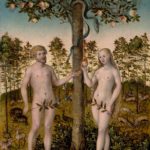
Lucas Cranach the Younger, “The Fall of Man,” 1549, oil on wood, the Museum of Fine Arts, Houston, Edith A. and Percy S. Straus Collection
Dr. Helga Aurisch is once again leading us on one of her marvelous tours through a remarkable exhibit – The Straus Collection of Renaissance Art at the Museum of Fine Arts Houston on March 22, 2018. Each piece on display could be the crowning jewel in any collection.
Here is what the MFAH tells us about this precious art.
Passion for Perfection: The Straus Collection of Renaissance Art
“When Edith and Percy Straus gave their remarkable collection of European art to the Museum of Fine Arts, Houston, in 1941, their generous donation marked a turning point for the MFAH.
“Since the Museum’s opening in 1924, its European collection had been relatively insignificant—a situation that changed dramatically with the Straus gift. The 83 objects that arrived in late 1944, after Percy Straus passed away, not only formed the cornerstone of the European art department, but also put the MFAH firmly on the map. Building on his father’s collection of Italian Renaissance paintings, Percy, together with his wife Edith, had acquired mainly Italian paintings of the late medieval and early Renaissance period, carefully guided by the best scholars in the field.
“Two artists—the painters of the Straus Madonna and the Sienese Straus Madonna—are named in honor of this collection that comprises their masterworks. Works by outstanding masters like Fra Angelico, Giovanni di Paolo, and Bartolomeo Veneto continue to be highlights of the MFAH collection.
“Besides these Italian paintings, the Straus Collection also includes exceptional works by Northern Renaissance masters such as Hans Memling and Rogier van der Weyden, as well as a number of 18th-century French and English paintings and works on paper. A fine group of Italian Renaissance bronzes, and a number of Northern and French sculptures from the 15th to 18th century, add yet another dimension to the collection.”
Also included is Saint Eustace, the largest of Albrecht Dürer’s engravings, and considered one of his finest. This scene depicts Eustace, the patron saint of hunters, in 15th-century clothing and reveals Dürer’s consummate skill in the representation of animals, plants, and landscape
We will meet in the museum café beforehand for some socializing. We’ll coordinate this with Dr. Aurisch, and will let you know the plans in plenty of time.
This event was originally planned for March 8, but was postponed to March 22, 2018.
